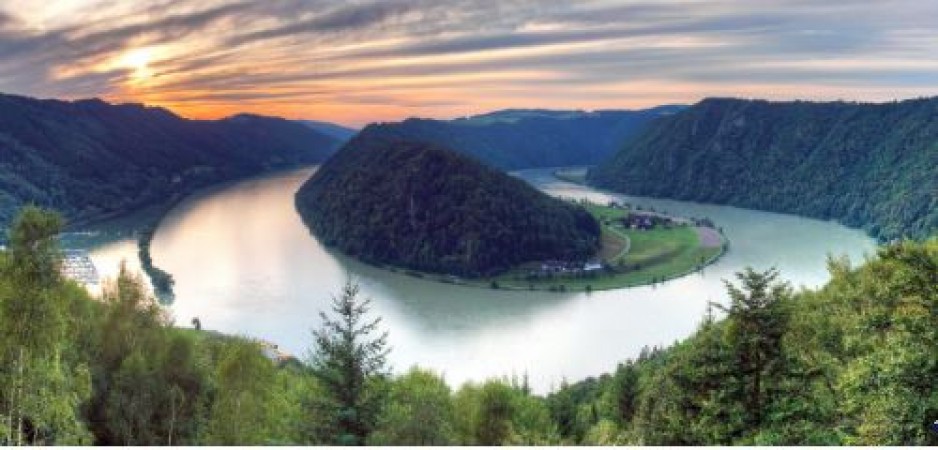
Danube River is the second largest river in the Europe. It flows through much to the central and the southeastern Europe. The Danube River often referred to as the "Queen of Europe's rivers," is one of the continent's most significant and majestic waterways. This iconic river has played a crucial role in shaping the history, culture, and economies of the regions it traverses. Its length, diverse landscapes, and rich history have made it a source of fascination and admiration for travelers and historians alike.
The Danube River originates in the Black Forest of Germany, near the town of Donaueschingen. The source is a small spring named "Breg," which is situated in a serene meadow at an altitude of approximately 1,078 meters (3,537 feet) above sea level. As the river gains momentum and volume, it flows eastward, cutting through the picturesque landscapes of Germany, Austria, Slovakia, Hungary, Croatia, Serbia, Bulgaria, Romania, Moldova, and Ukraine before finally emptying into the Black Sea.
Also Read: Exploring Alsace: A Timeless Blend
The river's journey spans approximately 2,850 kilometers (1,770 miles), making it the second-longest river in Europe after the Volga. Along its course, the Danube connects four capital cities - Vienna (Austria), Bratislava (Slovakia), Budapest (Hungary), and Belgrade (Serbia) - and numerous historically significant towns and cities.
The Danube River has long been a vital trade route and a cultural crossroad for various civilizations throughout history. Its banks have witnessed the rise and fall of empires, the mingling of diverse ethnicities, and the exchange of ideas and goods. The ancient Greeks called the river "Danubius," while the Romans named it "Danuvius." They recognized its strategic importance and used it as a boundary between the Roman Empire and the unconquered territories beyond its borders.
Also Read: Bhangarh Fort: The Haunting Mystique of India
In the Middle Ages, the Danube became a key trade route for merchants, facilitating the movement of goods between Central and Eastern Europe and the Byzantine Empire. The river also served as a natural barrier, protecting territories from invasions and offering strategic advantages in warfare.
Notable Cities and Landmarks:
Numerous cities and landmarks dot the banks of the Danube, each with its own unique history and charm. Some of the most notable ones include:
Vienna, Austria: The Austrian capital, located on the banks of the Danube, is renowned for its imperial palaces, cultural heritage, and classical music scene.
Budapest, Hungary: The "Pearl of the Danube," Budapest, is a city of stunning architecture, including the Buda Castle, the Hungarian Parliament Building, and the Chain Bridge.
Bratislava, Slovakia: The Slovakian capital boasts a mix of medieval, Gothic, and Baroque architecture and is known for its picturesque old town.
Also Read: Chasing Serenity: Discover the Most Breathtaking Sunset Spot in the Jaipur
Belgrade, Serbia: As one of the oldest cities in Europe, Belgrade stands at the confluence of the Danube and the Sava rivers, with a rich history dating back to ancient times.
Iron Gates: A scenic gorge located between Serbia and Romania, known for its dramatic cliffs and natural beauty.
The Danube River and its surrounding wetlands are ecologically significant, supporting a diverse range of flora and fauna. The Danube Delta, where the river empties into the Black Sea, is the second-largest delta in Europe and provides a crucial habitat for numerous bird species and aquatic life. The river also serves as a migratory pathway for various fish species, contributing to the biodiversity of the region.
Also Read: San Marino: A Microstate of History and Culture
However, the Danube has faced environmental challenges over the years, including pollution from agricultural runoff and industrial discharges. Governments and environmental organizations have been working to address these issues through initiatives such as the Danube River Protection Convention, aiming to preserve and protect the river's natural resources.
Throughout history, the Danube River has been a vital artery for trade and commerce. Today, it remains an essential transportation route for goods, facilitating trade between European countries and beyond. Riverports and harbors along its banks play a crucial role in facilitating the movement of goods, supporting the economies of the regions connected by the river.
Also Read: "Unveiling Italy's Enchanting Cities: The Top 10 Must-Visit Destinations
The Danube River is also a popular destination for river cruises and tourism. Tourists from all over the world are drawn to its breathtaking landscapes, historical sites, and the opportunity to explore multiple countries in a single journey. River cruises along the Danube offer travelers a unique perspective on Europe's cultural diversity and historical heritage.
The Danube River has deeply influenced the cultures of the countries it flows through. Folklore, traditions, and local customs are often intertwined with the river's existence. Many poems, songs, and stories have been inspired by the Danube, reflecting the emotional connection people have with this iconic waterway.
The Danube River's grandeur, historical significance, and environmental importance make it a true treasure of Europe. As it continues to flow majestically through the heart of the continent, the Danube remains a symbol of unity, connecting countries and people, and preserving the rich heritage of the regions it embraces. This mighty river will undoubtedly continue to inspire and captivate generations to come, solidifying its place as one of Europe's most beloved and iconic natural wonders.
Also Read: Edinburgh Castle: A Historic Icon Standing Tall
Discovering the Enchanting History: Exploring the Majestic Hill Forts of Rajasthan
Exploring the Enigmatic Amazon River: A Journey Through Nature's Wonderland